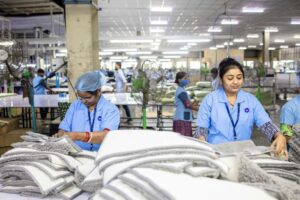
The Union Cabinet’s approval of the ELI scheme (Employment-Linked Incentive scheme) on July 1, 2025, is a timely intervention aimed at job creation and formalisation of employment in the manufacturing sector. The scheme, spearheaded by the ministry of labour and employment, is designed to incentivise first-time hiring and enhance social security coverage—two areas where India’s labour market continues to face structural deficiencies.
Under the scheme, employees registering for the first time with the Employees’ Provident Fund Organisation (EPFO) and earning up to ₹1 lakh annually will receive a one-month EPF wage support, capped at ₹15,000. Employers in the manufacturing sector, meanwhile, will be provided a ₹3,000 monthly incentive per new hire for two years. The scheme’s tenure runs through July 31, 2027, and seeks to generate over 3.5 crore new jobs in this period.
READ | Indian banks bet big on branches despite digital boom
In addition to employment creation, ELI promotes financial literacy, aims to formalise the workforce, and expands social protection—objectives critical to the structural transformation of India’s labour markets.
A gendered opportunity in manufacturing
The scheme’s emphasis on manufacturing is particularly significant given its demographic composition. According to the Periodic Labour Force Survey (PLFS) 2023–24, women account for 11.6% of the manufacturing workforce nationally and 24.1% in urban manufacturing. Overall, 85.9% of women remain in the informal sector, with 77.8% of women in manufacturing working as self-employed individuals. The sector also sees 54.9% of its female workforce operating as own-account workers or employers—highlighting the dominance of informal arrangements.
By linking incentives directly to new formal employment, ELI offers a pathway to transition these women into formal, secure jobs. But the challenge goes beyond job creation—it includes education, skilling, and working conditions.
The skilling imperative
The PLFS data reveals a concerning gap: most women in manufacturing have only completed education up to the middle or secondary level, with very few having attained higher education. As a result, women remain concentrated in unskilled or semi-skilled roles, primarily in textiles, food processing, and tobacco industries. These roles are characterised by low wages, lack of contracts, and poor workplace safety standards. The absence of crèche facilities, limited occupational mobility, and poor regulation of working conditions further compound the challenges.

To fully harness the potential of ELI, India must urgently invest in skill development for women in manufacturing. This includes tailoring skilling curricula to reflect technological advances, especially in Industrial Training Institutes (ITIs), and expanding access to upskilling and reskilling opportunities.
Lessons from Vietnam and the UK
International examples offer useful templates. Vietnam’s manufacturing boom has been backed by its investment in vocational education. An ILO study from 2025, Skills for Trade and Economic Diversification, notes that 2.5 million women are employed in Vietnam’s textile and garment sector, supported by 577 vocational training institutions offering programs at various levels. The Vietnamese government anticipated the demand for new skills brought about by digital transformation and acted accordingly.
Similarly, a 2023 policy brief by the Cambridge Industrial Innovation Policy titled Women in Manufacturing: The Case for Gender-Transformative Digitalisation underscores the need for gender-responsive skilling. It recommends reforms that include better work-life balance, childcare support, and skill enhancement to boost women’s participation and upward mobility in manufacturing.
Aligning ELI scheme with structural reform
The success of the ELI scheme depends on complementary policies. The Strategic Manufacturing Sector Skills Council under the National Skill Development Corporation must play a central role in aligning training programmes with evolving industry needs. Skilling efforts should focus not only on entry-level positions but also on enabling women to progress into supervisory and managerial roles.
Moreover, the inclusion of occupational safety and health (OSH) training, provision of childcare facilities, and other gender-sensitive workplace measures should be integrated into the scheme’s design. These are not peripheral concerns; they are central to attracting and retaining women in formal jobs.
With India now the sixth-largest exporter of textiles and apparel—commanding 4% of global trade as noted in the Economic Survey 2024–25—the ELI scheme offers a well-timed opportunity to deepen manufacturing competitiveness while addressing gender disparities in the workforce.
Dr Ellina Samantroy is Co-ordinator, Centre for Gender and Labour, VV Giri National Labour Institute.
